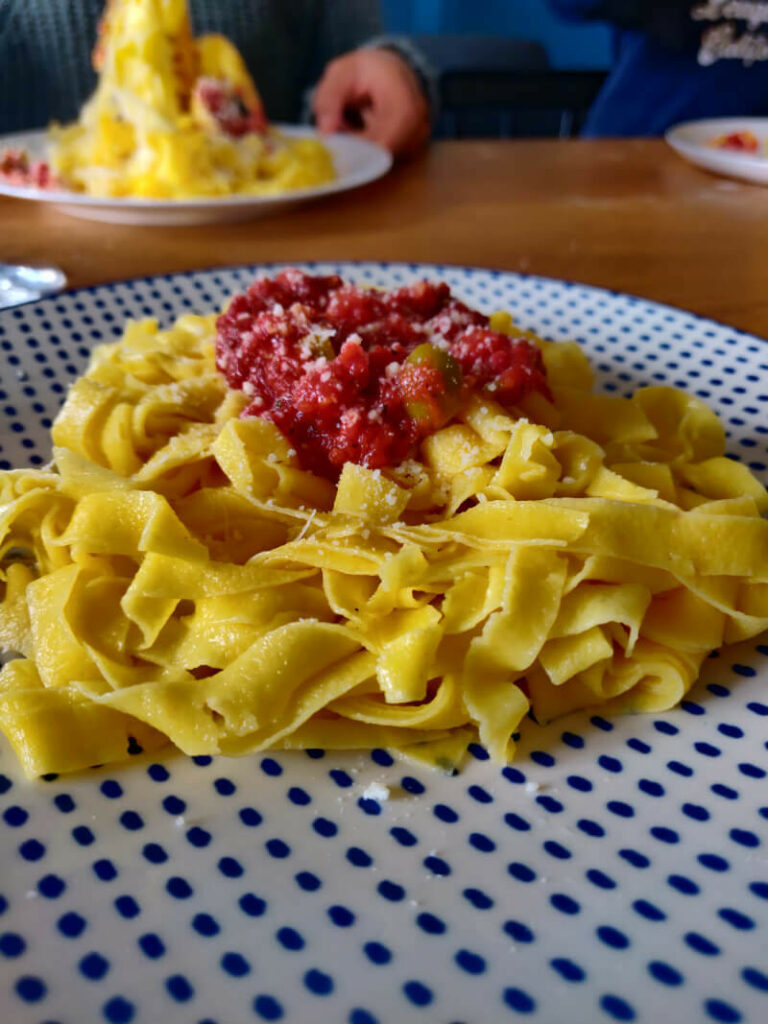There are different recipes, but this one is the most classic and simplest possible, as it only contains three ingredients: durum wheat semolina (which you can find in any supermarket, in the semolina section), eggs, and salt. That's it!
<< recipes

Share
Homemade Fresh Pasta for Pasta Machine

Public
Course: Main course
Preparation time: 20 minutes
Cooking time: 5 minutes
Energy: 46 kcal / serving
Instructions
- 1. Start by weighing the durum wheat flour, then place it on a clean work surface and make a well in the center of the flour mound. The well should be large enough to hold the three eggs.
Next, crack your three eggs directly into the well of flour. Using a fork, start by mixing the eggs together, then gradually incorporate the durum wheat flour. Be patient and do it gradually so that the dough mixes well. - 2. When the eggs are mixed with the flour and the dough becomes less liquid, finish mixing the dough and knead it with both hands. Use the palm of your hands to press firmly on the dough and shape it into a ball. Then, try to form a sort of rectangle. This will make it easier to pass through the pasta machine.
- 3. Using the rolling pin provided with the manual pasta machine, roll out the dough to form a rectangle of dough. Then, wrap the dough in plastic wrap and refrigerate for half an hour.
- 4. Now that the dough has rested, we will move on to the next step of the homemade fresh pasta recipe: making the pasta sheets with the pasta roller.
- 5. Preparing the pasta sheets with the pasta roller
Now, flatten the dough a little more while trying to maintain its rectangular shape.
Pass the dough through the pasta roller, starting with the widest setting, which is position 0. - 6. You will see that at first, the dough will crumble at the edges, and this may discourage you.
But don't panic, it's normal. Don't hesitate to stick the pieces of dough together and pass them through the pasta roller several times. You will see that gradually, the dough will no longer crumble and will hold its shape.
Once the dough passes through the pasta roller well, increase the setting using the notched wheel to gradually thin the dough until reaching the final setting.
Once the dough is very thin, you can stick the two ends together to create a loop, making the process easier. You don't need to put the dough back in the pasta roller, as the motion is continuous. - 7. Now that your pasta dough is very thin, you have sheets of pasta that resemble lasagna.
At this stage, you can cut them into pieces of 30 cm long using a pair of scissors. Don't forget to flour the pieces of pasta to prevent them from sticking together. - 8. Now, we will move on to the step of cutting the pasta.
Cutting homemade fresh pasta with the pasta machine
We will go to the other side of the pasta machine, the side used to cut the pasta into fettuccine (like here), but this pasta roller also allows you to make tagliolini. It's the most enjoyable part! The pasta literally forms right before your amazed eyes!
Lightly flour the machine to prevent the dough from sticking.
Place a sheet of dough in the machine and turn the crank. The dough will be cut into the shape of your chosen pasta. Isn't it magical? - 9. Once you have retrieved your fettuccine with your fingers, form a small pile and place it on a floured work surface. Do the same for all your sheets of pasta. Just a note: I form small piles to cook the pasta immediately, but if you want to cook them later, you need to dry them by hanging them on pasta drying racks, for example (some even use hangers!)
- 10. The final step of the homemade fresh pasta recipe: cooking
To cook your delicious pasta, whether it's tagliolini or fettuccine, start by bringing a large pot of water to a boil. Use one liter of water for every 100 grams of pasta, so here it would be 3 liters.
Once the water is boiling, generously salt it, then plunge the fettuccine directly into the water. Cook for 1 minute 30 seconds. - 11. After cooking, drain your pasta and serve it directly in pasta bowls. Generously coat it with your sauce (here, I used a classic Neapolitan sauce), then sprinkle with Parmesan cheese, and why not some pepper too!
Instructions with photos: https://www.legoutdespates.com/recette-pate-fraiche-maison-pour-machine/
Ingredients for servings
-
 300 g of durum wheat flour
300 g of durum wheat flour -
 3 eggs
3 eggs -
 salt (according to taste)
salt (according to taste)
Rates
-
No reviews
Nutritional information *
Attention: Nutritional data incomplete. Some ingredients have not been accounted for due to missing data. Check the ingredient list to identify the missing elements.
-
Per serving% RDA
-
Energy value46 kcal2 %
-
Fat3,24 g5 %
-
of which saturated0,87 g4 %
-
Carbohydrates0,09 g0 %
-
of which sugar0,09 g0 %
-
Protein4,19 g8 %
-
Fibers0 g?
-
More data
* As an indication, before cooking, RDA of the EU.
